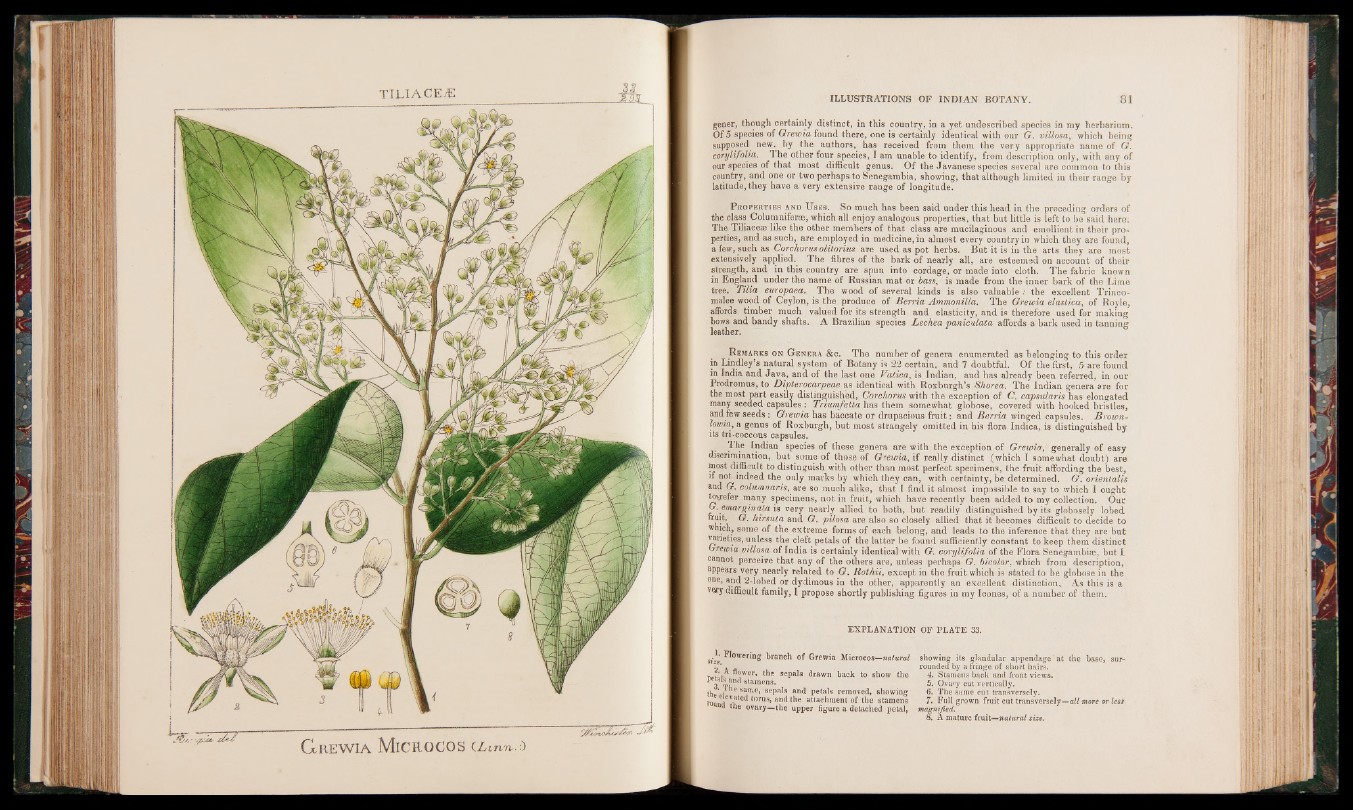
~ z r G rewia Microcos c l i n n . :)
S fâ n d h s& H J&
gener, though certainly distinct, in this country, in a yet undescribed species in my herbarium.
Of 5 species of Grewia found there, one is certainly identical with our G. villosa, which being
supposed new, by the authors, has received from them the very appropriate name of G.
corylifolia. The other four species, I am unable to identify, from description only, with any of
our species of that most difficult genus. Of the Javanese species several are common to this
country, and one or two perhaps to Senegambia, showing, that although limited in their range by
latitude, they have a very extensive range of longitude.
P rop erties and U s e s . S o much has been said under this head in the preceding orders of
the class Columniferæ, which all enjoy analogous properties, that but little is left to be said here.
The Tiliaceæ like the other members of that class are mucilaginous and emollient in their properties,
and as such, are employed in medicine, in almost every country in which they are found,
a few, such as Corchorus olitorius are used as pot herbs. But it is in the arts they are most
extensively applied. The fibres of the bark of nearly all, are esteemed on account of their
strength, and in this country are spun into cordage, or made into cloth. The fabric known
in England under the name of Russian mat or bass, is made from the inner bark of the Limé
tree, Tilia europaea. The wood of several kinds is also valuable .• the excellent Trinco-
malee wood of Ceylon, is the produce of Berria Ammonilla. The Grewia elastica, of Royle,
affords timber much valued for its strength and elasticity, and is therefore used for making
bows and bandy shafts. A Brazilian species Bechea paniculata affords a bark used in tanning
leather.
R emarks on G enera &c. The number of genera enumerated as belonging to this order
in Lindley’s natural system of Botany is 22 certain, arid 7 doubtful. Of the first, 5 are found
in India and Java, and of the last one V^atica, is Indian, and has already been referred, in our
Prodromus, to Dipterocarpeae as identical with Roxburgh’s Shorea. The Indian genera are for
the most part easily distinguished, Corchorus with the exception of C. capsularis has elongated
many seeded capsules : Triumfetta has them somewhat globose, covered with hooked bristles,
and few seeds : Grewia has baccate or drupacious fruit : and Berria winged capsules. Brown-
lowia, a genus of Roxburgh, but most strangely omitted in his flora Indica, is distinguished by
its tri-coccous capsules.
Indian species of these genera are with the exception of Gretoia, generally of easy
discrimination, but some of those of Grewia, if really distinct (which I somewhat doubt) are
most difficult to distinguish with other than most perfect specimens, the fruit affording the best,
if not indeed the only marks by which they can, with certainty, be determined. G. orientalis
and G. columnaris, are so much alike, that I find it almost impossible to say to which I ought
to^efer many specimens, not in fruit, which have recently been added to my collection. Our
G. cmarginata is very nearly allied to both, but readily distinguished by its globosely lobed
^ rsuta an^ pM°sa are also so closely allied that it becomes difficult to decide to
which, some of the extreme forms of each belong, and leads to the inference that they are but
varieties, unless the cleft petals of the latter be found sufficiently constant to keep them distinct
Gretoia villosa of India is certainly identical with G. corylifolia of the Flora Senegambiæ, but I
cannot perceive that any of the others are, unless perhaps G. bicolor, which from description,
appears very nearly related to G. Rothii, except in the fruit which is stated to be globose in the
one* %-lobed or dydimous in the other, apparently an excellent distinction. As this is a
very difficult family, I propose shortly publishing figures in my leones, of a number of them.
EXPLANATION OF PLATE 33.
size ^ 0werin£ branch o f Grewia Microcos—natural
haf*iA flower, the sepals drawn back to show the
3 T n<* stamens*
I}. ’ , e sa,Ae, sepals and petals removed, showing
rou«!ev*ted torus, and the attachment of the stamens
Q the ovary—the upper figure a detached petal,
showing its glandular appendage jj at the base, surrounded
by a fringe of short hairs.
4. Stamens back and front views.
5. Ovary cut vertically.
6. The same cut transversely.
7. Full growrn fruit cut transversely—all more or less
magnified.
8. A mature fruit—natural size.